Tire Recycling Market Research - 2032
The Global Tire Recycling Market size was valued at $11,980.9 million in 2018, and is projected to reach $18,137.8 million by 2032, growing at a CAGR of 3.3% from 2023 to 2032.
Tire recycling is a process of converting old and scrap tires that can no longer be used, into other products, such as pyrolysis oil, tire-derived fuel, and other rubber products. Various small-scale vendors also repurpose old tires into other useful products such as drinking water tanks for cattle, planters for planting trees in parks, and other products. It also includes the repair and retreading of old tires for reuse. Tire recycling gives the tire a new use; therefore, reducing its carbon footprint.
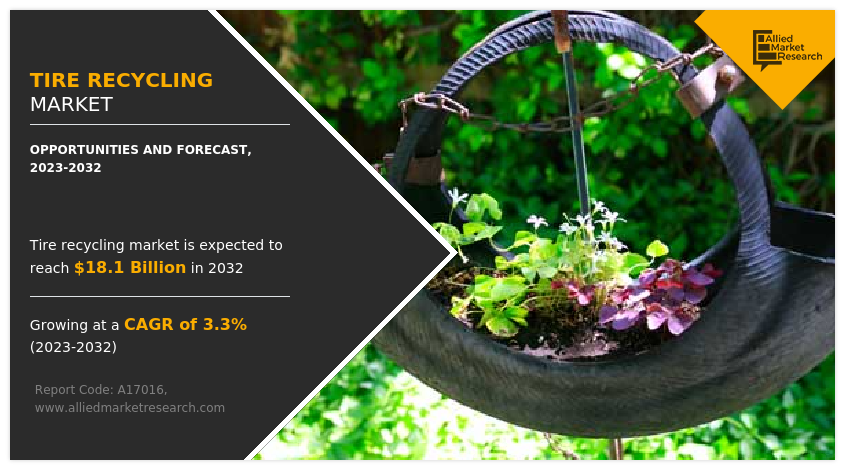
Tire Recycling Market Market Dynamics
The tire recycling market is primarily driven by factors such as growth in the number of automobiles, public and private initiatives for tire recycling, and problems associated with the disposal of scrap tires. Every year a significant number of vehicles are sold each year. According to Statista, 67.2 million automobiles were sold in 2022, and 66.7 million units were sold in 2021, marking an increase of 0.5 million. India and China have emerged as major automotive markets in the last decade. According to International Energy Agency, India has approximately 25 vehicles per thousand people as of 2020, and the number is expected to cross 150 by the year 2040.
In addition, according to the data from the European Union’s Eurostat, the total number of passenger cars in 2016 was 233,186,872, which increased to 253,305,631 in 2021. The rise in sales of private, commercial, and industrial automobiles in developed and developing economies is the sole reason for the increasing number of waste tires each year. More than 1 billion waste tires also known as End-of-Life Tires (ELTs) are generated across the world, accounting for 2% of total waste generated. The U.S. alone generates approximately 280 million scrap tires each year, according to the Federal Highway Administration Research and Technology.
Waste tires negatively impact the earth’s environment; thus, it becomes a dire need to properly dispose of them. However, landfill; a widely adopted method of waste management is not suitable for waste tires as they do not decompose and release chemicals into the air, ground, and water that alter the ecosystem. In addition, tires release methane under the sun, and their large stockpiles can catch fire, which is also a major environmental and health hazard. Thus, managing and disposing of the waste tires by recycling becomes important, and has proved to be the best method.
Tire recycling helps in reducing the need for harvesting raw materials for making tires and other rubber materials; thereby reducing greenhouse gases and preventing pollution. Recycling also saves a large amount of energy, which would otherwise be required to process freshly procured virgin material. Moreover, in the last 50 years tire recycling has increased by more than 8 times, whereas the new tire generation increased by only around six folds; thereby, indicating a rapid growth of tire recycling in coming years.
However, problems associated with the storage of scrap tires, expensive machinery, and strict government regulations restrain the market growth. For example, large storage of scrap tires is considered a fire hazard; therefore, many regulatory authorities have formulated rules and regulations for its collection, storage, and transportation. This is a major tire recycling market opportunity for the growth of key players in the market.
Moreover, the innovative use of tires in producing unique and groundbreaking products is anticipated to provide lucrative growth opportunities to the tire recycling market players. For instance, Acciona Infrastructure Group, a Spain-based sustainable project developer, is working on developing methods to reduce noise from trains on railroads, by incorporating waste tires.
The tire recycling market has witnessed various obstructions in its regular operations during COVID-19 pandemic; however, the upcoming recession is expected to be the next major global event to negatively affect the tire recycling market growth. Earlier, the worldwide lockdowns resulted in reduced industrial activities, eventually leading to reduced demand for recycled tire products such as tire-derived fuel, crumb rubbers, and others from various sectors such as construction, plastic manufacturing, the automotive industry, and other industrial sectors.
However, COVID-19 has subsided, and the major manufacturers in 2023 are performing well. Contrarily, the rising global inflation is a new major upcoming obstructing factor for the entire industry. The inflation, which is a direct result of the Ukraine-Russia war, and few long-term impacts of the coronavirus pandemic, is soon expected to push major world economies into recession. However, India and China are performing relatively well. In addition, inflation is expected to worsen in the coming years, as the possibility of the ending of the war between Ukraine and Russia is less.
Tire Recycling Market Segmental Overview
The tire recycling market is segmented on the basis of process, product, application, and region. By process, the market is bifurcated into pyrolysis, shredding, refurbishing. Furthermore, the refurbishing segment is further categorized into retreading and reconditioning. Depending upon the product, the tire recycling market is categorized into tire derived fuel, crumbed rubbers, refurbished commercial vehicle tires, and others. On the basis of application, it is divided into manufacturing, construction, rubber products, automotive, and others. Region wise, it is analyzed across North America, Europe, Asia-Pacific, Oceania, Africa, Middle East, and Latin America.
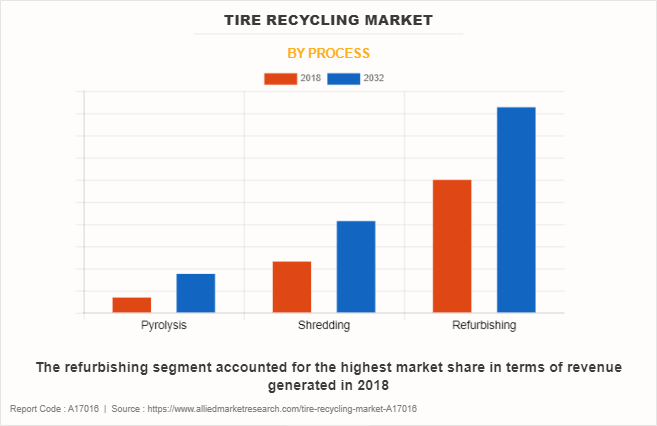
By Process:
The tire recycling market is bifurcated into pyrolysis, shredding, refurbishing. Furthermore, the refurbishing segment is further categorized into retreading and reconditioning. In 2022, the refurbishing segment dominated the tire recycling market share, in terms of revenue, and the pyrolysis segment is expected to grow with a higher CAGR during the forecast period. Tire refurbishing primarily includes tire repair and tire retread. The casing of tires has a long lifespan, however, their treads which are always in touch with roads suffer wear and tear and need to be repaired or applied with a new tread layer. Refurbishing a tire is a cost-effective and sustainable solution, as it minimizes waste generation and reduces the demand for new tire production. On the other hand, the reason behind the higher CAGR of the pyrolysis segment is the growth in demand for pyrolysis oil, carbon black powder, scrap steel wires, and gas, which can be used in various industrial processes.
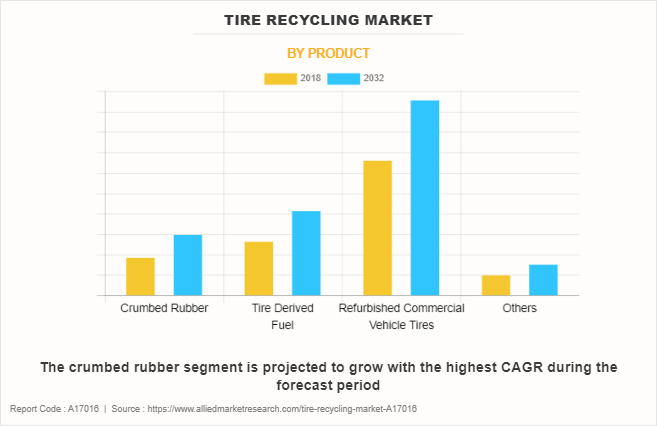
By Product:
The tire recycling market is divided into tire derived fuel, crumbed rubbers, refurbished commercial vehicle tires, and others. In 2022, the refurbished commercial vehicle tires segment dominated the tire recycling market, in terms of revenue, and the crumbed rubber segment is expected to witness growth at a higher CAGR during the forecast period. Refurbished commercial vehicle tires have been recognized by many as an environment-friendly option against buying a new tire. Moreover, crumbed rubber segment is owing to its versatile application in various industries such as automotive, sports, construction, railway, and various others.
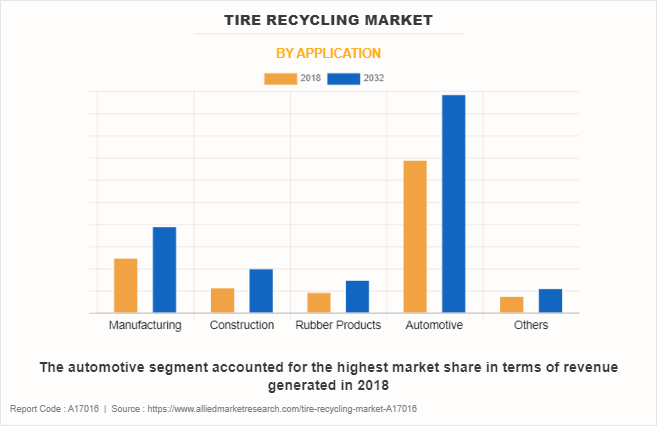
By Application:
The tire recycling market is divided between manufacturing, construction, rubber products, automotive, and others. The automotive segment accounted for a higher market share in 2022, owing to the rise in the automotive segment which uses recycled tire products in manufacturing of its various products. However, the construction segment is anticipated to register a higher growth rate throughout the forecast period.
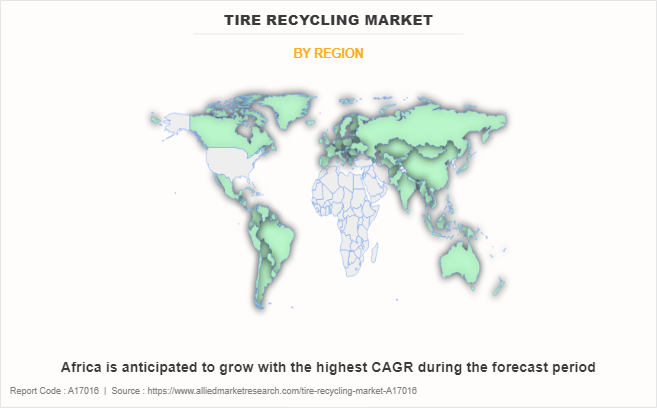
By Region:
Asia-Pacific accounted for the highest tire recycling market share in 2022 and Africa is expected to grow with a higher CAGR throughout the projected period. China is a major tire consumer and producer. Major tire manufacturers in China are expanding their businesses to meet the demand for tires across the world. For instance, Shandong Linglong Tire, a Zhaoyuan-headquartered tire manufacturer, has invested $680 million in development of a manufacturing base in Changchun automotive economic zone. This plant is anticipated to have a capacity of manufacturing 12 million passenger and 2 million truck/ bus tires/year and 200,000 truck/bus retreads/year. In addition, Sailun Group has expanded its manufacturing capacities in the China. Moreover, other countries such as India, Japan, South Korea are also contributing in the growth of the tire recycling market.
For instance, in September 2021, Indian government introduced PLI (Production Linked Incentive) scheme for automobile and auto components worth $ 3.49 billion. Moreover, Agile Process Chemicals LLP operate in India and offer various tire recycling solutions. Such factors are anticipated to increase the number of scrape tires in the coming years, thereby; driving the demand in the tire recycling market in Asia-Pacific. Furthermore, rapidly growing disposable income of people in LAMEA is expected to increase the number of cars in the region, eventually increasing the number of tires discarded each year. For example, Latin America comprises many emerging economies such as Brazil, Chile, and Argentina. The demand for automobiles is considerably high. However, the COVID-19 induced component shortage is a big hinderance in automobile production. In the coming years, the market is anticipated to witness a boom, as this component shortage subsides. Moreover, Michelin, a tire manufacturer has begun construction on its first tire recycling plant in Chile. It is expected to recycle 30,000 tons of earthmover tires. Such instance is anticipated to drive the demand for tire recycling in during the forecast period.
Competition Analysis
Competitive analysis and profiles of the major players in the tire recycling market are provided in the report. Major companies in the report includes, Apollo Tyres Ltd, Bridgestone Corporation (Bandag LLC), Champlin Tire Recycling, Inc, Contec, Continental AG, Emanuel Tire, LLC, Entech Inc., Genan Holdings A/S, Green Distillation Technologies Corporation LTD., Liberty Tire Services LLC (Lakin Tire), Michelin Group S.A., Re-Match Holding A/S, reRubber, LLC., Tire Disposal & Recycling, Inc., Tyre Recycling Solutions SA, and Wastefront AS.
Major players in the tire recycling market adopt development strategies such as product launch, partnership, product development agreement, business expansion, and others to remain competitive. For instance, in February 2020, Michelin North America, launched two new pre-mold retreads under its MICHELIN X Multi D Pre-Mold retread line. This innovative product provides improved durability against scrubbing and enhanced traction while maintaining excellent mileage performance. Similarly, in December 2023, Continental AG planned to further develop its retread process and retread training.
Key Benefits for Stakeholders
- The report provides an extensive analysis of the current and emerging tire recycling market trends and dynamics.
- In-depth tire recycling market analysis is conducted by constructing market estimations for key market segments between 2022 and 2032.
- Extensive analysis of the tire recycling market is conducted by following key product positioning and monitoring of top competitors within the market framework.
- A comprehensive analysis of all the regions is provided to determine the prevailing opportunities.
- The tire recycling market forecast analysis from 2023 to 2032 is included in the report.
- The key players within the tire recycling market are profiled in this report and their strategies are analyzed thoroughly, which helps understand the competitive outlook of the tire recycling industry.
Tire Recycling Market Report Highlights
| Aspects | Details |
| Market Size By 2032 | USD 18.1 billion |
| Growth Rate | CAGR of 3.3% |
| Forecast period | 2018 - 2032 |
| Report Pages | 250 |
| By Process |
|
| By Product |
|
| By Application |
|
| By Region |
|
| Key Market Players | Tyre Recycling Solutions SA, Emanuel Tire, LLC, Green Distillation Technologies Corporation LTD., Apollo Tyres Ltd., Wastefront AS, Champlin Tire Recycling Inc., Re-Match Holding A/S, Contec S.A., Tire Disposal and Recycling, Inc., Entech Inc., Genan Holding A/S, Continental AG, Michelin Group S.A., reRubber, LLC., Liberty Tire Services LLC (Lakin Tire), Bridgestone Corporation |
Analyst Review
The tire recycling market has witnessed significant growth in the past decade owing to a rise in concerns over the surge in environmental pollution, caused by improper management or discarding of end-of-life tires.
The automobile industry plays an essential role in the development of any economy. It produces vehicles that support the movement of goods and people. This eventually leads to a quick growth of the economy. However, the production of more vehicles leads to the production of more tires, eventually more waste tires. This is a major factor driving the growth of the tire recycling market. Moreover, there are various ways of managing tire waste including pyrolysis, recycling, retreading, and energy recovery.
Moreover, the rate of tire recycling in countries such as Japan, South Korea, the U.S., and countries in Europe is very high. For example, in 1996, only around 50% of the total waste tire generated in Europe were recycled, however by 2019, around 95% of the waste tires in Europe were recycled. However, the global average of tire recycling is only 25%, indicating the high potential for growth of the market.
Moreover, the rise in awareness regarding tire recycling positively influences the tire recycling market.
The market was valued at $11,980.9 million in 2018 and is expected to reach $18,137.8 million by 2032, growing at a 3.3% CAGR.
It's the process of converting old tires into products like pyrolysis oil, tire-derived fuel, and rubber products.
Major players include Acciona Infrastructure Group and others focusing on innovative uses of recycled tires.
North America leads the market in tire recycling.
Growth in automobile sales, public initiatives, and the need for proper disposal of scrap tires are key drivers.
Challenges include storage issues, expensive machinery, and regulatory constraints on scrap tire management.
Loading Table Of Content...
Loading Research Methodology...



